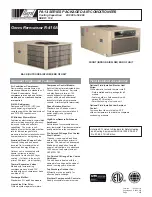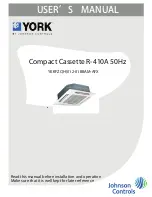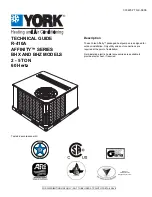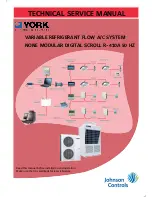
33
Outdoor-Air Inlet Screens
Outdoor-air inlet screen must be in place before operating unit.
Compressor Mounting
Compressors are internally spring mounted. Do not loosen or re
-
move compressor hold down bolts.
Internal Wiring
Check all factory and field electrical connections for tightness.
Tighten as required.
Refrigerant Service Ports
Each unit system has two
1
/
4
-in. SAE flare (with check valves)
service ports: one on the suction line, and one on the compressor
discharge line. Be sure that caps on the ports are tight.
Compressor Rotation
On 3-phase units with scroll compressors, it is important to be cer
-
tain compressor is rotating in the proper direction. To determine
whether or not compressor is rotating in the proper direction:
1. Connect service gages to suction and discharge pressure
fittings.
2. Energize the compressor.
3. The suction pressure should drop and the discharge pressure
should rise, as is normal on any start-up.
If the suction pressure does not drop and the discharge pressure
does not rise to normal levels:
4. Note that the evaporator fan is probably also rotating in the
wrong direction.
5. Turn off power to the unit and install lockout tag.
6. Reverse any two of the unit power leads.
7. Re-energize to the compressor. Check pressures.
The suction and discharge pressure levels should now move to
their normal start-up levels.
NOTE: When the compressor is rotating in the wrong direction,
the unit will make an elevated level of noise and will not provide
cooling.
Cooling
Set space thermostat to OFF position. To start unit, turn on main
power supply. Set system selector switch at COOL position and
fan switch at AUTO. position. Adjust thermostat to a setting ap
-
proximately 5°F (3°C) below room temperature. Both compres
-
sors start on closure of contactors.
Check unit charge. Refer to Refrigerant Charge section.
Reset thermostat at a position above room temperature. Both com
-
pressors will shut off. Evaporator fan will shut off immediately.
To shut off unit, set system selector switch at OFF position. Reset
-
ting thermostat at a position above room temperature shuts unit off
temporarily until space temperature exceeds thermostat setting.
Main Burners
Main burners are factory set and should require no adjustment.
To check ignition of main burners and heating controls, move
thermostat setpoint above room temperature and verify that the
burners light and evaporator fan is energized. Check heating ef
-
fect, then lower the thermostat setting below the room temperature
and verify that the burners and evaporator fan turn off.
Refer to Table 12 for the correct orifice to use at high altitudes.
Heating
1. Purge gas supply line of air by opening union ahead of the gas
valve. If gas odor is detected, tighten union and wait
5 minutes before proceeding.
2. Turn on electrical supply and manual gas valve.
3. Set system switch selector at HEAT position and fan switch at
AUTO or ON position. Set heating temperature lever above
room temperature.
4. The induced-draft motor will start.
5. After a call for heating, the main burners should light within
5 seconds. If the burner does not light, then there is a
22 second delay before another 5 second try. If the burner still
does not light, the time delay is repeated. If the burner does
not light within 15 minutes, there is a lockout. To reset the
control, break the 24 v power to W1.
6. The evaporator-fan motor will turn on 45 seconds after burner
ignition.
7. The evaporator-fan motor will turn off in 45 seconds after the
thermostat temperature is satisfied.
8. Adjust airflow to obtain a temperature rise within the range
specified on the unit nameplate.
NOTE: The default value for the evaporator-fan motor on/off de
-
lay is 45 seconds. The Integrated Gas Unit Controller (IGC) modi
-
fies this value when abnormal limit switch cycles occur. Based
upon unit operating conditions, the on delay can be reduced to
0 seconds and the off delay can be extended to 180 seconds.
If the limit switch trips at the start of the heating cycle during the
evaporator on delay, the time period of the on delay for the next
cycle will be 5 seconds less than the time at which the switch
tripped. (Example: If the limit switch trips at 30 seconds, the evap
-
orator-fan on delay for the next cycle will occur at 25 seconds.) To
prevent short-cycling, a 5 second reduction will only occur if a
minimum of 10 minutes has elapsed since the last call for heating.
The evaporator-fan off delay can also be modified. Once the call
for heating has ended, there is a 10-minute period during which
the modification can occur. If the limit switch trips during this pe
-
riod, the evaporator-fan off delay will increase by 15 seconds. A
maximum of 9 trips can occur, extending the evaporator-fan off
delay to 180 seconds.
To restore the original default value, reset the power to the unit.
To shut off unit, set system selector switch at OFF position. Re
-
setting heating selector lever below room temperature will tem
-
porarily shut unit off until space temperature falls below thermo
-
stat setting.
Ventilation (Continuous Fan)
Set fan and system selector switches at ON and OFF positions, re
-
spectively. Evaporator fan operates continuously to provide con
-
stant air circulation. When the evaporator-fan selector switch is
turned to the OFF position, there is a 30 second delay before the
fan turns off.
FIELD CONTROL WIRING
The 48LC unit requires an external temperature control device
such as a thermostat (field-supplied).
THERMOSTAT
Install a Carrier-approved accessory 3-stage thermostat according
to installation instructions included with the accessory. If a 3-stage
cooling thermostat is not available, use a 2-stage cooling thermo
-
stat instead, but note that this will limit cooling to just 2 stages.
Locate the thermostat accessory on a solid wall in the conditioned
space to sense average temperature in accordance with the ther
-
mostat installation instructions.
If the thermostat contains a logic circuit requiring 24-v power, use
a thermostat cable or equivalent single leads of different colors
with minimum of eight leads. If the thermostat does not require a
24-v source (no “C” connection required), use a thermostat cable
or equivalent with minimum of seven leads. Check the thermostat
installation instructions for additional features which might re
-
quire additional conductors in the cable.
Содержание 48LC 14
Страница 27: ...27 Fig 38 Integrated Gas Control IGC Board RED LED STATUS...
Страница 81: ...81 Fig B Typical Electromechanical Control Wiring Diagram 48LC 14 26 APPENDIX D WIRING DIAGRAMS...
Страница 82: ...82 Fig C 48LC 14 26 Systemvu Control Schematic APPENDIX D WIRING DIAGRAMS...
Страница 83: ...83 Fig D 48LC 14 26 RTU Open Control Wiring Diagram APPENDIX D WIRING DIAGRAMS...
Страница 85: ......
















































